The trek through Peru’s Colca Canyon will test your limits, push you to your breaking point, and reward you with some of the most stunning views to be had anywhere in the world. This is one of Peru’s most popular trekking destinations and the second deepest canyon in the world. Though it can be done as a two-day trek, I recommend taking 3 to 5 days to explore this unique and gorgeous location. For those who are on a budget, or who are just fiercely independent, let’s go over how to trek Colca Canyon without a guide.
I made a five-day trek through this beautiful Canyon back in December 2015, and to this day it is one of my most memorable trekking experiences. Something about the depth of the canyon, the colors of the desert landscape, and the unique combination of wilderness and Peruvian culture made this trek stick out in my mind. I did it without a guide and for under $200 and I’d love to share some of my insights with you.

All About Colca Canyon
Before we get started on the how, let’s get into the why. Colca Canyon is one of the most exceptional natural landscapes in Peru. And Peru is a country filled to the brim with jaw-dropping landscapes. But really, Colca Canyon sticks out among the rest.
Once billed as the deepest canyon in the world, Colca Canyon has since been forced to cede that crown to a nearby, but less well-known canyon. Still, second deepest canyon in the world just ain’t that bad, reaching a depth of 10,730ft (3,270m). As a comparison, the Grand Canyon in the United States is only 6,093ft deep.
Located about 8 hours from Arequipa, this Canyon sits below now dead volcanoes and is cut through by the Rio Colca. At the northern end of the Canyon sits the town of Chivay. Up here, the canyon is more of a fertile valley, characterized by small villages and ancient pre-Incan terracing.
As you travel south down the only road on the top of the canyon, you’ll pass by 56 different small villages. The river runs beside you through the valley until suddenly, just a few miles before the final town, it drops away and the canyon opens up below you. The last town perched on the edge of the canyon is Cabanaconde. This is the starting point for the trek.
Colca Canyon is home to a wide variety of unique flora and fauna, the most famous of which is the Andean Condor. This majestic bird can live 70 years and has a wingspan of up to 9 feet. In the Incan mythology, the flying Condor represents heaven.
The people who live in and around Colca Canyon come from two separate cultures: the Cabana culture are a Quechua speaking people, and the Collagua culture are an Aymara speaking people. They continue to live on the land to this day, practicing traditional culture and cultivating their pre-Incan terraces.
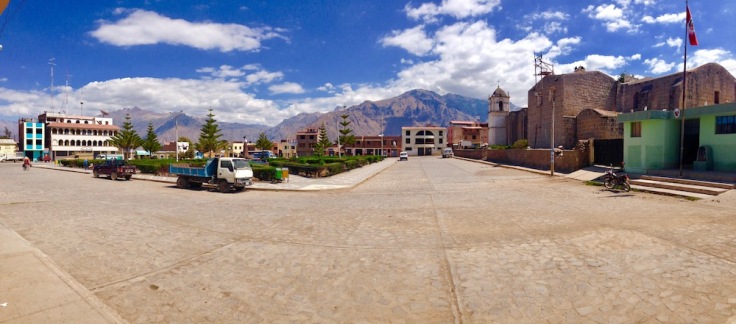
How to Get to Colca Canyon
Your journey begins from Arequipa, a town that sits slightly inland from the ocean in the middle of a vast desert. You’ll want to get a bus from Arequipa to Cabanaconde. If you can’t find a time to Cabanaconde that works for you, you can get a bus to Chivay and transfer to a local bus that goes from Chivay to Cabanaconde.
From Arequipa, there are several bus companies that run to Cabanaconde. I took Turismo Milagros. Buses to Cabanaconde leave at a range of times, from about 1am until mid-morning. We took a 4am bus that got us to Cabanaconde in time for lunch.
Expect the entire bus journey to take upwards of 8 hours. This bus ride is long, reaches high elevations, and can get extremely cold. Bring a jacket! I didn’t have enough layers and I was freezing in the high elevations.
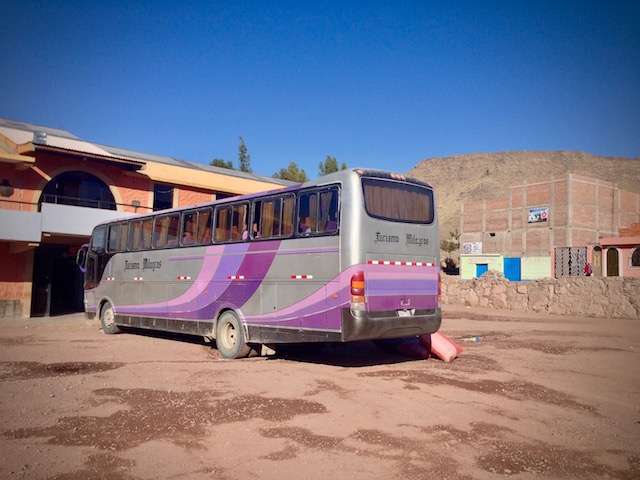
The Itinerary: A 5 Day Trek in Colca Canyon Without a Guide
Day 1: Cabanaconde to San Juan de Chuccho
Day 2: San Juan de Chuccho – Tapay – Malata
Day 3: Malata – Fure – Llahuar
Day 4: Llahuar Hot Springs Day of Rest and Joy
Day 5: Llahuar – Cabanaconde
Without further ado, let’s get into the nitty gritty of what to expect when you hike Colca Canyon without a guide.
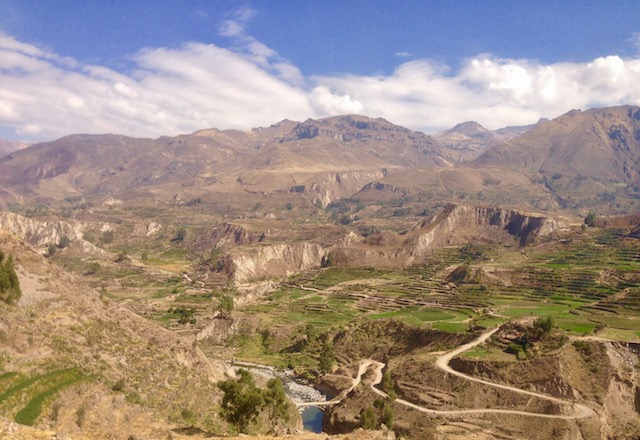
What to Pack for Colca Canyon
When I made this trek in 2015, I did it with a partner and we intended to hike completely unassisted. We had the advantage of being based out of the Cusco area where I was living for work at the time. I had brought all of my camping equipment with me when I moved to Peru, so we didn’t need to rent any gear.
For those who are traveling without tents and sleeping bags and stoves, there are guesthouses in certain towns in the valley. For more information about trekking Colca Canyon and staying in guesthouses, I recommended reading this blog post, or this one. You might also be able to rent tents and camping bags and such in Arequipa, but I’m not sure about that.
We carried all of our food into the canyon with us and were able to feed ourselves and cook our own meals until we got to Llahuar, which as you’ll read, by that point we were so starving and tired we were more than happy to pay 10 soles for a home-cooked meal.
For clothing, bring a couple layers. The canyon is in a desert and as such is primarily hot and dry but we did get a few drops rained down on us on the first day, and it got a little chilly at night. I appreciated having my fleece with me during the evenings.
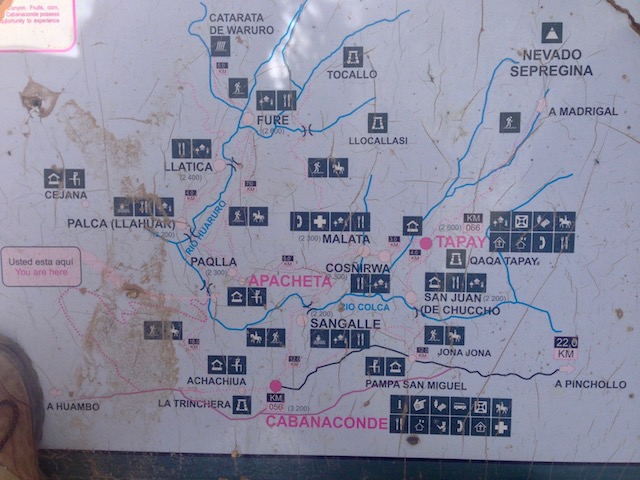
A note about maps: ideally you should always trek with a topographical, accurate map of the region where you’ll be hiking. To the best of my knowledge, one of those does not exist for this canyon. The best we could find was a cartoon map not drawn to scale. Hopefully, you have better luck.
Day 1: Cabanaconde to San Juan de Chuccho
Our bus from Arequipa dropped us off in the central plaza of Cabanaconde right around lunchtime. We grabbed a quick menu from a shop on the square then walked off to buy some cookies and head for the trailhead.
To get to the trailhead for San Juan de Chuccho, head back out of town up the paved road. After a little while, you’ll see a sort of church and a small soccer field with some bleachers on your left, the trailhead is behind that soccer field. Follow the footpath with hiking boot footprints in it.
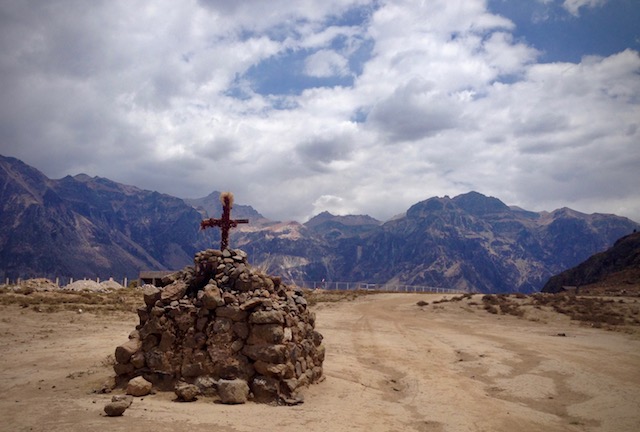
Pretty soon you should start to see some signs pointing you towards a Mirador, towards Tapay, and a kilometer indicator that reads 00. This is the beginning of the long, winding trail to the bottom of the canyon.
The trail begins by cutting along the side of the canyon, offering stunning views to the north and south, as well as a peek down to where you’ll end your day. After this easy beginning, the trail heads down and down and down. In places, it can be quite steep, with slippery loose rock underfoot.
All told, it took us about 3 hours to reach the bridge at the bottom of the canyon, but we may have been slowed down by our heavy packs and camping supplies.
When you reach the canyon floor, you’ll come to a bridge and find a representative who will check your boleto turistico. Cross the bridge and follow the path along the river until you reach San Juan de Chuccho.

For those hiking without camping gear, there are two guesthouses in San Juan de Chuccho, Roys house or Rivelina’s house. They are probably pretty similar. We camped in an open grassy area below Rivelina’s house and paid them 5 soles for the privilege. Since we brought our own food and camping stove, 5 soles was the total cost of our day.
Day 2: San Juan de Chuccho to Malata via Tapay
We woke early the next morning, ate a quick breakfast of oatmeal, and packed up our campsite. This would be our first full day of hiking in the canyon and we were pumped. As we headed out of San Juan de Chuccho, we struck up a conversation with a local who suggested we hike uphill to Tapay.
I’m sure they had a reason for suggesting this, but in retrospect, I cannot for the life of me remember what it could have been. Maybe the church? Or the views? Anyway, we decided to follow their advice, though it led to a day far more wild than what I had expected.

A small trail cuts off of the main road just outside of San Juan and heads uphill towards Tapay. I believe this may have been a local trail. There is a far more well defined and easier trail that heads to Tapay from the bridge from the day before, but we didn’t want to backtrack. Take the local trail, we thought. What could possibly go wrong?
We followed it up through some terraces and farmland, hiking as the sun rose above us and the day got hotter and hotter. We stopped at one point to dip our heads into some cool water flowing down from the mountains far above.
At some point in the terraces, our local trail failed us. It narrowed from a trail to a path, and a path to a “maybe that’s it over there…” and pretty soon we found ourselves climbing through terraces and working our way slowly uphill, trying to reassure each other that eventually, we’d come upon another road to Tapay.
Instead, we came upon a landslide.

Clearly quite recently, a large section of the earth that sat below Tapay had given up the game and come loose, descending into the canyon below in a rush of dust, stone, and heavy boulders. Most sensible people would see a landslide like this and decide to turn back, realizing that Tapay just wasn’t in the cards. We were not sensible people. We pushed on.
If you ever find yourself in this situation, do not do this. Landslides are incredibly dangerous, especially recent ones. You can never be certain that the rocks above you won’t come loose and come crashing down. Choosing to muddle our way up and across a fresh landslide was foolhardy and not worth the risk.
But that’s what we did. It took ages and was unbelievably hot, but we clambered through the freshly fallen silt, our feet sinking into the loose rock up to our knees until we finally worked our way up to the newly constructed road. From there it was a short and easy jaunt into Tapay.
Was Tapay worth a near-death experience? Absolutely not. It’s a small village with a cute church and nice views up and down the canyon. If you can take a regular and safe path to get there, go right ahead. If you decide to follow in my rambling and untrustworthy footsteps, then on your own head be it.
Finally in Tapay, we paused to take some photos and appreciate the view from the church plaza, ate a quick lunch, then descended down the far easier, and well-trafficked path that headed towards Cosñirhua. The little path took some tight switchbacks down then rejoined the road running along the side of the canyon. We followed this for the rest of the day, overlooking Cosñirua then finally stopping to camp for the night somewhere in the vicinity of Malata.
We camped in an unused terrace with the permission of the family living nearby. They were generous enough to let us sleep and cook in their fallow field for free. We bought some cookies and beer from their shop instead.
Day 3: Malata to Llahuar via Fure
From Malata, we followed the main road up to a small rise, overlooking Sangalle, better known as the Oasis, down below us. Though the swimming pools and verdant green fields looked tempting, we were determined to experience the fringes of this deep canyon.
Turning our backs on the Oasis, we headed uphill towards Fure.
Fure is a small village tucked away rather far from the rest of the tourist trail. The draw of Fure is the waterfall that sits a further hour’s hike from the village itself. To get there from Malata, the trail was an undulating ribbon of rock cut through a dry and barren land.
We made it to Fure fairly late in the afternoon and although we began to hike down the trail towards the waterfall, we had to admit that we were pushing our luck. Our goal was to camp in Llahuar that evening, but it was certainly going to be at least 3 more hours of hiking until we got there.
Our plan was to hike to Llahuar today and spend tomorrow resting in the hot springs below the village. After the three incredibly intense days of hiking in the canyon, we both felt we deserved a bit of a break and a bit of a soak.
As we sat on some rocks next to the trail, we pondered our two options. Continue towards the waterfall and camp tonight somewhere near Fure, hiking to Llahuar tomorrow and forgoing our rest day, or forgo the waterfall now in favor of hot springs tomorrow?
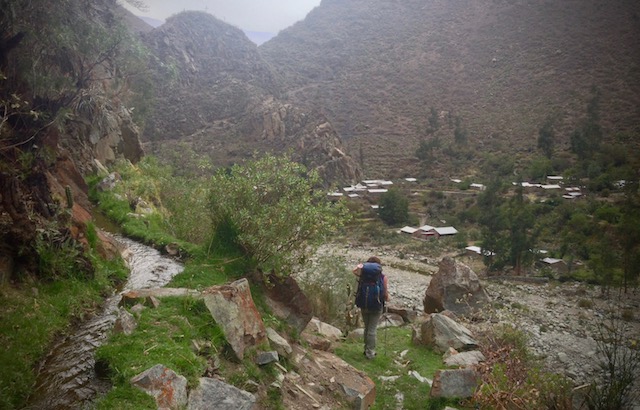
We chose the hot springs.
Abandoning the waterfall, we headed back through Fure. Though I hear that it has guesthouses and shops during the high traffic tourist season, in December of 2015 this village was a ghost town. The shops were closed, there was no sign of a guesthouse. If you arrived here without a guide and without campaign gear in mid to late December, you might find yourself without a place to sleep that night.
Slowly we made our way back down the hillside to Llahuar. It was a long and relentless hike, through farmland, down steep mountainsides, and along irrigation canals. My feet were sore and my legs were rubber by the time we saw Llahuar nestled among the cliffs down below us.

Llahuar itself is a great little village, with a hostel perched above the river and hot springs down below. We met the owner of the hostel, paid a small sum to camp on the grass near the hot springs, then headed up to her restaurant to have our first home cooked meal in two days. The fare was simple, but at the time I felt I had never eaten anything so extravagantly delicious.
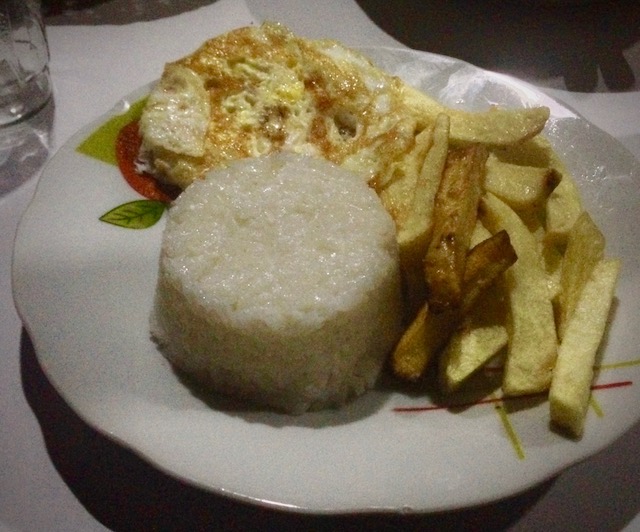
I slept like a baby that night, eager in anticipation for my day of soaking in hot springs.
Day 4: Resting in Llahuar
Because of the madness of our previous three days of hiking, we made the executive decision to spend an entire day relaxing in the hot springs below Llahuar. It was the best decision we could possibly have made. We pretty much had the place to ourselves. We bought some beers from the hostel and hung out in the steaming hot waters all day, soaking our sore muscles and preparing ourselves for our massive ascent up the canyon wall on the following day. When the water got too hot, we jumped into the icy rushing river below, then slipped back into the warm, sulfurous waters of the hot springs.
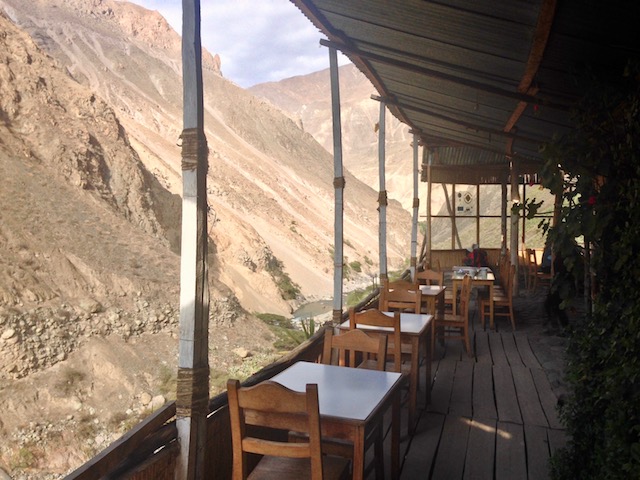
It was heaven.
If you’re hiking Colca Canyon without a guide and have the extra time, I highly recommend taking a rest day in Llahuar. It is totally worth the 5 or 10 soles you’ll pay to camp and eat there.
Day 5: Llahuar to Cabanaconde
Resisting the urge to hitch a ride on the back of the pickup truck that was making the ride from Llahuar to Cabanaconde that morning, we packed up our bags, said goodbye to our elysian hot springs, and began the long and arduous climb up to Cabanaconde.
Up and up and up, that’s all you can expect from this day of hiking. The day gets hotter as the sun rises and you ascend the sheer, rocky, barren walls of the second deepest canyon in the world.
But have no fear, eventually, you’ll get to the top. And then you have to walk a further hour to get back to Cabanaconde.
I exaggerate, but it certainly felt that way after our five-hour climb out of the canyon.
Once back to Cabanaconde, we had a pretty difficult time finding a bus to take us back to Chivay, but I think that’s because it was in that weird time between Christmas and New Years when no one wants to work or do anything. After an hour or two of begging every truck that drove past, we hitch a ride sitting in the back of an open pickup truck.
From Chivay, it was pretty simple to hop onto the next bus for Arequipa. You can’t miss it. There will be at least five men shouting “Arequipa Arequipa Arequiiiiippaaaaaa” in your face the moment you walk in the door of the bus station.
The Takeaway: Colca Canyon is a Hikers Paradise
As with many of the hiking destinations in Peru, Colca Canyon is a treat and a half. Sheer rock walls, verdant green farmland, challenging trails and hospitable locals all make for a wonderful multi-day trek. Combine that with the fact that it’s totally doable without a guide and without real camping gear and you’ve got yourself a winner. Hiking Colca Canyon without a guide is fun, rewarding, and easy. Just do it.
Like this post? Pin it!
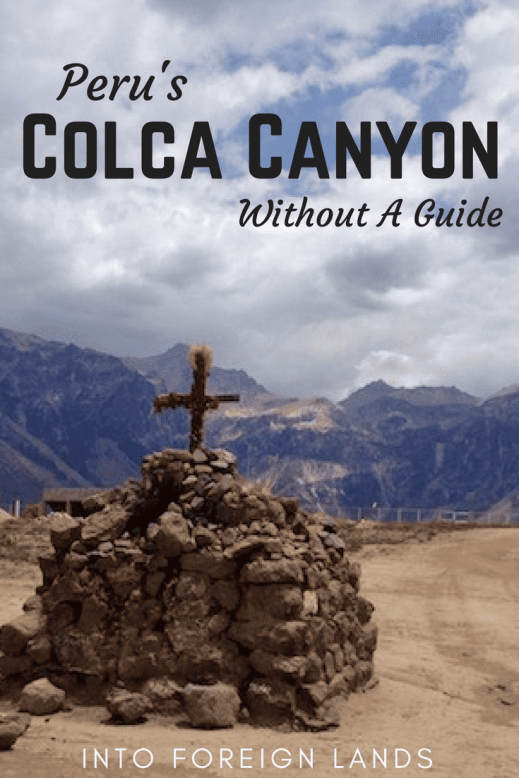
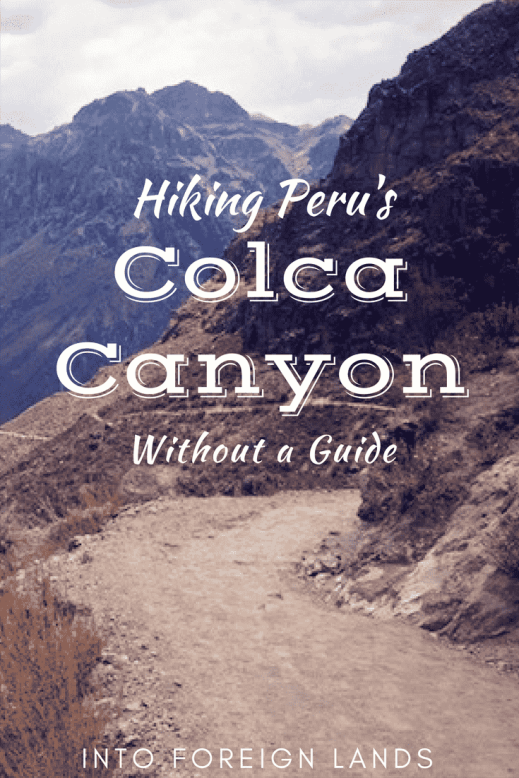




Colca Canyon looks incredible! Sounds like the tough trekking paid off with the views and the hot springs 🙂
LikeLike
Totally! Colca Canyon is well worth the pain of a tough trek 😀
LikeLike
WOW! You’re right the views are incredible and I’d be all over those hot springs! Hiking without a guide and getting lost is one of my biggest fears…but I’d totally look into doing something like this with a guide. I assume there are guided options as well?
LikeLike
Yes! There are many ways to hike Colca Canyon with a guide, you can arrange it through travel agencies before you travel to Peru or organize it from the main city of Arequipa. Peru is great for tours.
LikeLiked by 1 person
Woah this is such a beautiful trek! I just love the bare landscape that is so pure and barely touched. Sounds like it was quite the adventure, glad you managed to reach a well-earned break at the hot springs!
LikeLike
Very interesting read, thanks for sharing. I especially loved the picture of your meal. Hiking always makes me hungry as a bear and it feels SO GOOD to eat afterwards. I’ve never been on this trail but look forward to pinning for later.
LikeLike
It does feel SO good to eat a cooked meal after a long trek! One of the best little pleasures in life. Hope you can make it to Colca someday.
LikeLike
This place looks spectacular! I can’t believe I’ve never heard of it before. It’s almost impossible to imagine a canyon that deep even having been to some pretty large ones myself. I love that there’s a spot to relax in some hot springs to recharge for the rest of the hike too.
LikeLike
Wow this looks like quite a hike! I need to work on doing something like this!
LikeLike
What an incredible place! Such a great achievement, you must be so proud of yourself. Seemed like quite the adventure but so rewarding. I’m not much of a hiker but if I was, I’d be going here.
LikeLike
This sounds like such a cool experience. I consider myself a hiker, but I think I’d have to really prepare – physically and mentally – for a trek like this. Peru is on my bucket list, and I’ll definitely look into hiking through Colca Canyon.
LikeLike
I think if you’re already a hiker, you can definitely tackle Colca Canyon! Staying at the guesthouses each night would make it easier, for sure.
LikeLike
This brought back so many fun memories from Peru. I did not get to visit Colca Canyon, actually just hearing about it today but I have plans to revisit in future and I’ll love to visit. Looks amazing.
LikeLike
Yay! Glad it brought some memories for you. Colca Canyon is definitely worth a visit if you make it back to Peru. Its in my top 5 spots in the country.
LikeLike
This is the first time I’ve heard of Colca Canyon! Props to you for making the trek without a guide. Those hot springs must’ve been so rewarding at the end.
LikeLike
They were absolutely wonderful!
LikeLike
I have never heard of this place before and it looks amazing. Initially I thought you had done the trek on your own, not only without a guide but also without companion but now I see I was wrong. It is nice to see that even with a proper map you managed to move around without many problems. Thanks for sharing your tips!
LikeLike
Yeah, this time I did the trek with a partner, though I’ve done other similar treks just on my own. It was nice to share this one with someone.
LikeLike
I loved peru! so sad we didn’t make it to this place though, will have to go back one day! 🙂
LikeLike